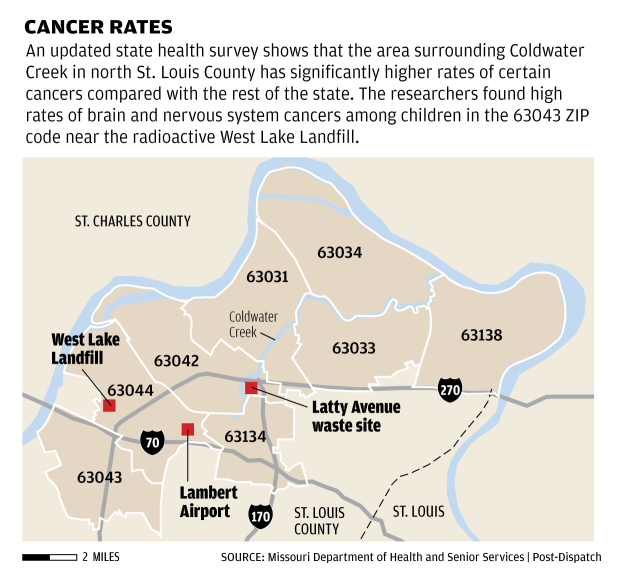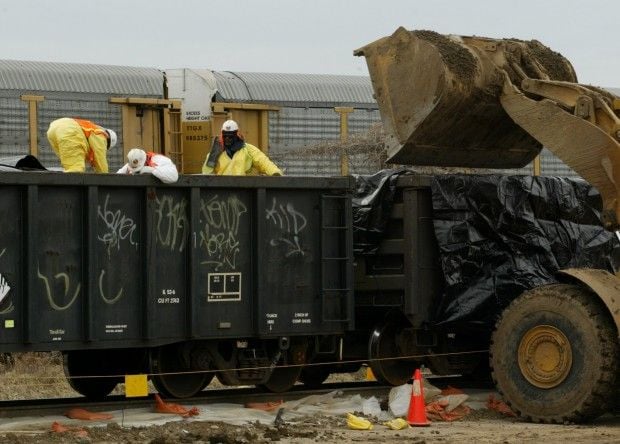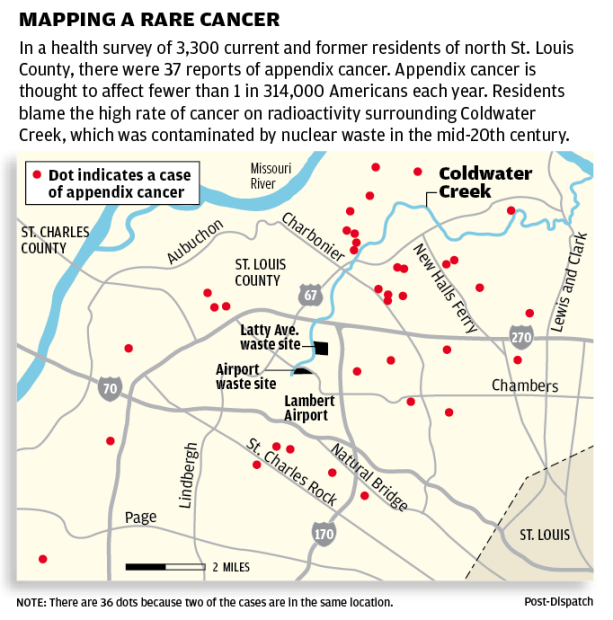St. Louis Post-Dispatch
by Blythe Bernhard
In a sharp shift, state health officials are asking for help to investigate whether high rates of cancers in north St. Louis County are linked to nuclear contamination of Coldwater Creek, which residents have long feared is causing rare illnesses.
 Gail Vasterling, director of the Missouri health department, wants the Centers for Disease Control and Prevention to design a study to explore the possibility of a connection between cancer rates and environmental hazards in North County. Vasterling said the request was based on concerns from the public, the history of nuclear waste in St. Louis, and the results of a cancer survey released Tuesday.
Gail Vasterling, director of the Missouri health department, wants the Centers for Disease Control and Prevention to design a study to explore the possibility of a connection between cancer rates and environmental hazards in North County. Vasterling said the request was based on concerns from the public, the history of nuclear waste in St. Louis, and the results of a cancer survey released Tuesday.


The new state report shows high rates of leukemia, breast, colon and other cancers in the areas surrounding Coldwater Creek, which was contaminated by nuclear waste after World War II. The creek runs from St. Ann to the Missouri River through Florissant, Hazelwood, Black Jack and Spanish Lake.
The report updates a 2013 survey that showed no higher risk of the types of cancer expected from radiation exposure among people living near the creek. Any higher rates of other cancers, the department then blamed on poverty and poor health.
For the new survey, the state’s disease investigators added seven years of cancer data through 2011, more rare types of cancers and two ZIP codes (63043 and 63044) in Maryland Heights and Bridgeton nearest the radioactive West Lake Landfill, where the same nuclear waste was dumped in the 1970s.
The additional data show there were 455 cases of leukemia reported in the area from 1996 to 2011, 44 more cases than would be expected in the population over that time period. That indicates a statistically significant increase in the blood cancer that has been associated with radiation exposure.
The findings prompted Vasterling to ask the CDC for a study that could get closer to linking the cancers to the nuclear waste by measuring the historical and current levels of radioactive exposure among residents near the toxic dump sites.
St. Louis was involved in the development of atomic bombs during World War II when uranium and radium were extracted from ore and processed at the Mallinckrodt chemical company downtown. Radioactive byproducts were taken to a 22-acre open storage site by the airport from 1946 through the 1950s.
Coldwater Creek, which makes up the western edge of the waste site, became contaminated. Around 1973, some of the waste was illegally dumped at West Lake Landfill.
The airport waste sites and Coldwater Creek are part of a cleanup program through the Army Corps of Engineers that is considered close to completion. The landfill is a Superfund site under the Environmental Protection Agency, which has not decided on a cleanup plan for the site. Cleanup is complicated by the underground fire at the adjacent Bridgeton Landfill.
Community members asked the state to add the two ZIP codes to the cancer study because of concern about the landfills.
State health investigators found a high rate of brain and nervous system cancers among children 17 and younger in the 63043 (Maryland Heights) ZIP code near the landfill. There were seven such cancers in that age group from 1996 to 2011, compared to an expected 2.5 cases based on rates across the state.
Parents of children at Rose Acres Elementary school in 63043 believe the number of cancers among students and staff members has recently increased, and have asked the state health department for a separate disease investigation at the school.
“The fact that we live so close to the oldest nuclear weapons waste in the world means that the health department should have been watching out for us,” said Dawn Chapman, whose son goes to Rose Acres. “Something is causing these people over here to get sick.”
A few years ago, several alumni from McCluer North High School in Florissant noticed a spike in rare cancers among classmates now in their 30s and 40s. They started their own nonscientific survey, which found more than one-third of 3,300 current and former residents of north St. Louis County have developed cancers, including more than 40 rare appendix cancers. Their findings were one reason the St. Louis County health department hired three epidemiologists this year to study environmental risk factors in the area.
The state’s most recent survey did not find an abnormally high rate of appendix cancers among residents of the area. Diane Whitmore Schanzenbach, one of the McCluer North alumni group’s leaders and a professor at Northwestern University, said a main problem with the state surveys is they don’t include people who lived near the creek when it was contaminated but have since moved away.
“It raises enough questions that you want more answers, and I hope that they’ll give us more answers,” she said.
Cancer clusters are notoriously difficult for scientists to link to environmental hazards in part because the disease is so common. One in two men and one in three women will develop cancer at some point in their lives.
Vasterling of the state health department said investigators were “unable to conclude whether exposure to radiological contaminants … may have contributed to increased cancer risks in the area,” but that the CDC could potentially design a more technical research project to answer those questions.

